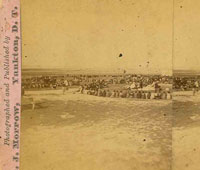Throughout the 1800s, annuities played a big role in Native Americans losing their lands to the US Government. During this period it was quite common for the government to entice the Indians into trading their vast lands for trinkets and guaranteed annuities, often at rates that constituted gross underpayment. The tribes were forced into smaller areas, where their only real income was those annuities. When the Native Americans needed additional money to purchase food and clothing, they could only buy from certain Government-approved traders, who would extend credit to the Indians. As the Indians' debts to these traders increased, the tribes were forced to sell more land to cover their loans. In one instance, the Governor of Indiana, which was then a territory, settled seven treaties in four years with First Nations in southern Indiana, Wisconsin, Missouri, and Illinois. The natives sold their land for what amounted to two cents an acre (in some cases less), paid in guaranteed annuities. Historians generally agree that the First Nations, in this and many other cases, were deceived in selling at this price.
Land treaties signed by the First Nations are, technically speaking, legitimate legal documents. They received goods, annuities, or a sum of money in return for a parcel of land. Later, however, these seemingly legitimate exchanges left many native peoples agrieved and bewildered, as they had never truly understood what they were selling. To them, there was no such thing as private property, so it is likely they were unaware that they would no longer be able to use the land after they sold it. To make matters worse, the treaties were often negotiated under duress. Native leaders were bribed and softened up with alcohol, and when that didn't work, threats were often made to stop payments on annuities from past treaties. Whenever these strategies failed, the US government was also not averse to sanctioning militant efforts to force the Native Americans off their lands.
As time went on, a number of Native American tribes became increasingly dependent on annuity payments and so were compelled to sell more and more land to the federal government. In a span of fourteen years the Potawatomi tribe, for one, signed six land treaties, which resulted in the tribe giving up large swaths of land in Illinois, Michigan, Wisconsin, and Indiana. Instead of turning against the government, this tribe from the Chicago area became so reliant on annuities that they would do anything to protect their flow of payments. This included acting as peacemakers on behalf of the government when, in 1827, their kindred Winnebago tribe from southern Wisconsin threatened to rise up against white settlers.
The use of annuities as an instrument to deceive native peoples out of their ancestral lands is a significant, if regrettable, episode in the history of annuities and in the history of the United States. At the Annuity Museum you can browse our collection of Indian documents and photographs relating to such annuities to get a glimpse of life during this turbulent time.


